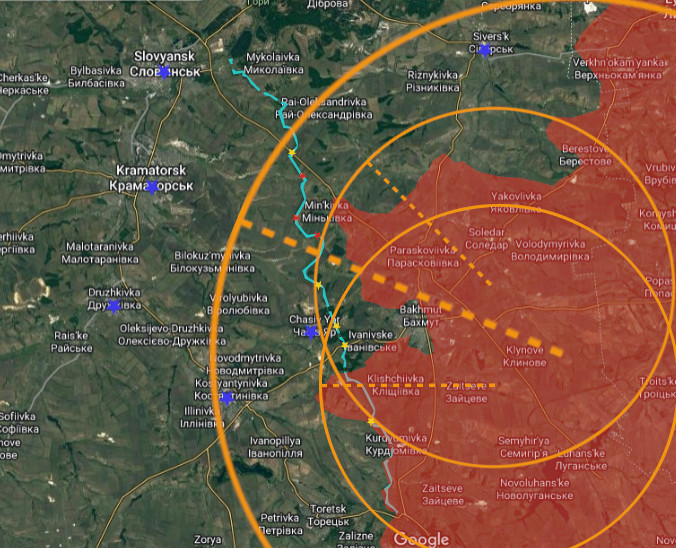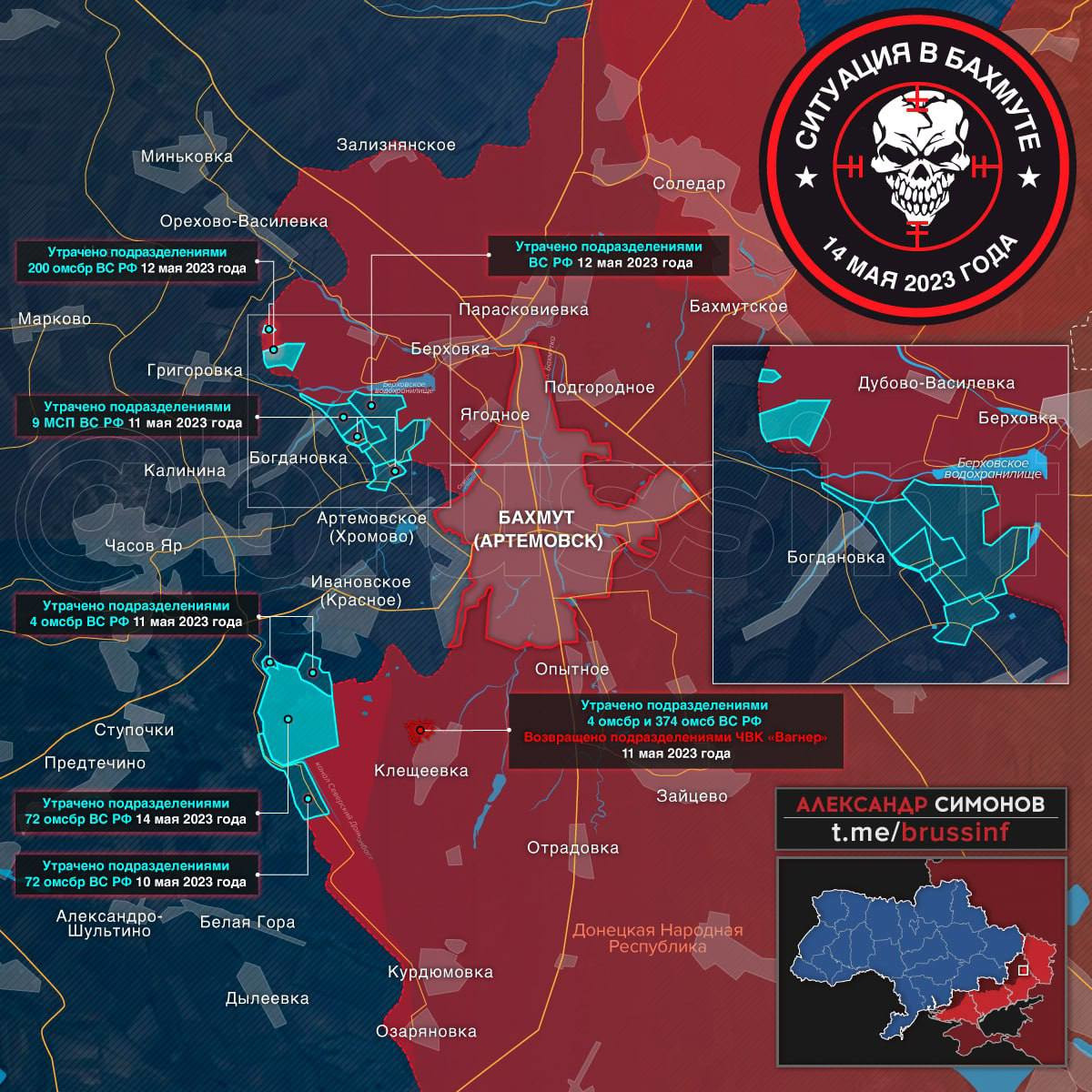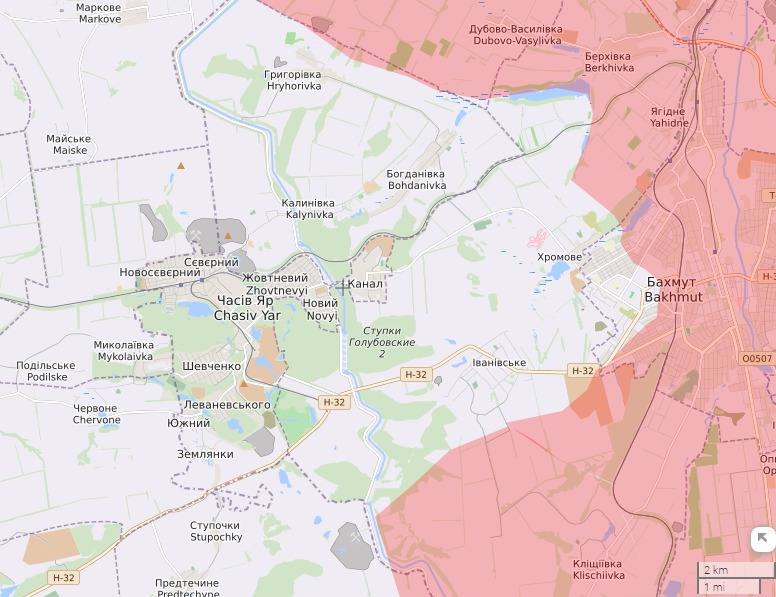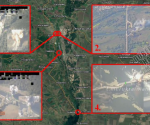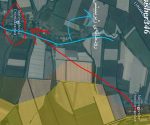A catalogue of setbacks for the anti-Russian axis; Part One: the Artyomovsk counterattack that failed
Over the course of the weekend just gone there was a battle in what the Russians call the “Artyomovsk-Soledar direction”, and principally in what here has been dubbed the “Chasov Yar wedge” where Russian regular forces threw back several Ukrainian attacks.
It was most likely the local counterattack on Artyomovsk that some anticipated and some did not – as discussed in the two-part FBEL article, The Anti-Russian Axis’ Big Propaganda And Military Defeats In Artyomovsk (One & Two). The author thought that it would so certainly end in a bad Ukrainian defeat that it wouldn’t be tried, but now that it has must therefore understand it to be an act of desperation in reaction to a primary failure to muster a multi-theatre offensive, or at least the one that has been long prophesised to happen in Zaporozhye.
The bigger picture just introduced here is going to be inspected across the course of a number of parts to this article; this part, of course, is about the drubbing the Ukrainians took between the 11th and 15th May in a local attacking operation in the location already specified.
When he was creating a map for the previous article introduced above, the author suspected that he would be using it to explain a Ukrainian operation against Artyomovsk in the remote event of one [please consult the previous publication for an explanation of the annotation]. This means, reader, that if any chuckle-head can look at a map and understand what the Ukrainians would do, the Russian staff certainly could. This is how desperate the Ukrainians were.
To ease into the exercise, the reader is invited to compare the aforementioned map and one garnered from “pro-Russian” social-media that, in its usual way, wants to frighten its audience with pronouncements of Ukrainian gains. The Russians may or may not have physically moved out of the areas marked in blue – it doesn’t matter: the Ukrainians certainly will not have permanently occupied them as is suggested (notice that Liveuamap doesn’t claim them for Ukraine in the third map below, also dating from 14th May).
In any case, the task is to notice the containment of these areas within the “Chasov Yar wedge”, and consider the question of Ukrainian access to this area – meaning the triangle defined by red shading between Chasov Yar and Artyomovsk. Think about what would need to be done to attack in this area as opposed to what would need to be done to stage from anywhere else but Chasov Yar. After a look at the Russian Ministry of Defence’s description of events – which will better facilitate it – there will be a return to a discussion related to what is being shown in the maps.
On 12th May the Russian MoD at first reported a large scale Ukrainian operation having taken place the day before along 95km of line centred, it seems, on Soledar. Potentially the stated distance could incorporate the front from Belogorovka (“Bilohorivka”) in Lugansk down to “Maiorska” near to where the canal that defines the “Chasov Yar wedge” ends, but there could be more focussed localness about the Ukrainian operation than is suggested (the author just doesn’t have that information). 26 attacks were launched involving “more than 1,000 servicemen, up to 40 tanks and other military and special-purpose equipment”. We are told that closer to Artyomovsk the Russians occupied an altered line of defence “taking into account the advantageous conditions of Berkhovskoye reservoir”, which leads us to understand that that there was consolidation against the “Chasov Yar wedge”. The reservoir mentioned can be seen on the third map and is the body of water aside the settlement labelled “Berkhivka”.
Receiving mention for heroics in this first report – something that would be repeated at a later date – were the ”soldiers” of the Russian 4th and 200th motorised rifle brigades. This information suggests that the Russians were blocking with the fire of their forward positions, or mobile, or manoeuvrable elements, and not just relying on the Ukrainians to come forward under standoff fire.
The Russians were quite clear about the decisiveness of the day’s events by stating that all the Ukrainian attacks had been repelled, and no penetration of Russian lines had been achieved.
Ukrainian casualties were typically heavy, however. 540 Ukrainian personnel were killed, reports the Russian MoD, with 8 tanks and more than 20 other armoured vehicles being lost. That being said, for the entire Donetsk direction during this particular period of 24 hours, Ukrainian casualties were unusual: the Russians reported 900 Ukrainians killed and wounded. A daily figure for killed in action in this theatre usually ranges from 200 to 300. What can be inferred from all the data, perhaps, is that the stand-off attacks on Ukrainian positions close to Chasov Yar and Bogdanovka (“Bohdanivka”), that one can read about in Russian MoD briefings on a more or less daily basis, happened on this day to find more Ukrainian exposure to them.
With nothing unusual happening to note on the 12th, the Russian MoD then reported on 14th May that
The enemy made massive attempts to break through Russian troops’ defence to the north and south parts of Artyomovsk in the past 24 hour.
All the attacks of the Armed Forces of Ukraine (AFU) have been repelled. There has been no breakthrough in the defence of Russian forces.
What followed was an unusually detailed account. South of Krasnoye, or Ivanovskoye, which is the settlement on the third map on the H-32 road as it passes through the “wedge”, the 4th Motorised Rifle Brigade killed and wounded “around” 200 Ukrainians. If one looks at the map and imagine the Russians to be somewhere in the area bound by, going from west to north, the canal, forest, and the settlement itself, one can imagine the Ukrainians approaching through the gap in the waterway and then the trees – the former provides access through a natural defensive barrier, and the latter provides cover.
On the “pro-Russian” Ukrainian fan-fiction map, it should be noted, this area of access and cover has been given over to blue, indicating it was captured from the Russians. We’ll return to this momentarily.
The Russian MoD briefing goes on to say that the Ukrainians also lost 3 tanks, 4 infantry fighting vehicles, and 2 other armoured vehicles. However, at the end of the engagement, Colonel Vyacheslav Makarov, the commander of the Russian 4th Rifles and leading from the front, was wounded and subsequently died during evacuation.
East of Bogdanovka (“Bohdanivka”), the Russian MoD also reports, the 3rd Battalion of the 200th Motorised Rifle Brigade faced attacks from a force “involving over 100 Ukrainian assault unit servicemen, seven tanks, 14 infantry fighting vehicles and other military and special-purpose equipment.” Of this force, the Ukrainians lost all tanks, 11 of the IFVs, and over 50 personnel.
If one looks at the third map, south of “Kalynivka”, there’s a gap in the waterway against some forest to the east, which is bound on the north by a road to Bogdanovka. It can be imagined that, staging from Chasov Yar, the Ukrainians used this point of entry into the wedge.
Somewhere else in the same general area – the Russians don’t state exactly where – the 6th Motorised Rifle Division repulsed an attack by “enemy assault units supported by three tanks and four infantry fighting vehicles”, making the Ukrainians lose 30 personnel, 2 tanks, and 3 IFVs.
The other detail that the Russian MoD wanted to tell of was the death of another officer casualty, Deputy Army Corps Colonel Yevgeny Brovko, also leading somewhere on the battlefield in harm’s way.
As normal, the Ukrainians also had to contend with Russian aviation – 24 sorties were made during this particular day – and the artillery of the said brigades (presumably) and generally of the organisational grouping in the area, which performed 107 firing missions. This detail is noted because, by comparison with the statistics for the other days between the 11th and 14th, is shows Russian stand-off fire activity was intensified quite considerably. The Russians were able to escalate when the need arose, and this is important.
In total, reported the Russian MoD, in the “Soledar-Artyomovsk direction” on this day, the Ukrainians lost over 400 servicemen killed and wounded, 12 tanks, 18 IFVs, and 2 armoured fighting vehicles (and a D-20 howitzer).
With the Russian MoD reporting today that the 4th Motorised Rifles were yesterday repelling new attacks around Krasnoye (“more than 70 Ukrainian servicemen, an infantry fighting vehicle, as well as two armored personnel carriers were destroyed”), it looks like what was a substantial operation to strike back at Artyomovsk has been entirely broken down. Now, this wasn’t necessarily about recapturing the city, rather than executing the plan which had the best chance of achieving good optics (as always, for the primary sake of preserving Ukrainian morale).
As it turns out, and quite contrarily, the Ukrainians have only further revealed their weakness , and from that their desperation. For it looks as though while the operation began broadly, and the author suggests in a diversionary capacity in places other than the “Chasov Yar wedge”, it really boiled down to using the topography in that locality to mitigate the appalling lack of Ukrainian air defences that were demonstrated by the Russians actually being able to step up stand-off fire, especially by aviation, in quite the dramatic way. It’s clear from the first map above that Chasov Yar offered the Ukrainians the means to stage an attack closest to Russian positions. Moreover, the town was served with access across the canal unlike at any other stretch of that waterway. Finally, the forest allowed cover for the approach to Russian positions, whereas in contrast, the landscape to the north where access to it is not blocked by waterway is a relative open plain.
As said before, anyone looking at the maps should have seen that a main Ukrainian thrust (the one which a broader campaign would develop into) must come through the “wedge” – it was the option that was most possible. As it happens, the Russians broke the entire operation down so that the Ukrainians have had to recoup from day to day and try again at their main objective – not once but twice, and with increasing limpness.
Of course, there’s a public relations trick that the UK/Ukrainians encourage (propaganda nonsense is London’s speciality, the UK military will undoubtedly be ultimately responsible for Kiev’s), which is to show blue map which indicates territory that Ukraine has supposedly retaken from Russian occupation. It’s a scoreboard that can be referred to for geeing-up morale. The thing is, however, the Ukrainians have never “retaken” any territory during the whole course of the SMO, because the Russians have never yet been beaten in a defensive fight which involved their forward manoeuvrable elements. The Russians, instead, employed a mobile defence in Kharkov, so that there was only rear-guard action, and hit that Ukrainian operation with stand-off fire until it ran out of steam, and Kherson was simply conceded, but not before the Ukrainians were plenty bloodied. Much has been written of this simple truth at this site – please take it upon yourself, reader, to search to discover it so that there doesn’t have to be repetition now.
And to cut a long story short, the blue in the map above is as dishonest as any other. It’s true that the Russians were on the western side of the canal in the south, but it was a completely obviously exposed position. If this is where an (invented) Russian regular battalion fled from ahead of Ukrainian aggression according to “Mouthpiece” – what the author has taken to calling Prigozhin of the Wagner PMC because of how he is clearly not in any serious charge of anything – then it merely reinforces that about him which has just been stated. To prevent the risk of becoming isolated, the Russians would naturally have moved behind the canal.
Moreover, the blue marked nearby on the map to the east of the canal would be where the Russians were surely going to let the Ukrainians traverse in order to reach the open ground and become exposed. Again, the Russians would have made the choice to leave the way clear, and the Ukrainians wouldn’t have had to force the Russians from it.
As for the large blue space in the north, this is simply where the Russians withdrew so as to be on the other side of not one but two bodies of water, if one looks closely. This would be the place “east of Bogdanovka” where the Ukrainians took the invitation to be savaged.
In the aftermath of the day’s work of the 13th – that one which saw the Ukrainians beaten north and south in the “Chasov Yar wedge” – it was thought fitting by the Supreme Commander-in-Chief of the Armed Forces of the Russian Federation, i.e. Putin, that Russian servicemen so deserving of them should receive military decorations, and that there should be no delay in doing it. More than 120 Russian servicemen were awarded medals that very day and in their combat positions.
As far as the author is aware this was unusual, and he’s certainly never read anything else like it in a Russian Ministry of Defence briefing. The reason for it could well be that this action is quite possibly the first significant time the Russians have defended, with men on the ground blocking with their bodies against the Ukrainians, at their line in the sand – meaning the point after which there cannot be any retiring for the forward, manoeuvrable elements of the Russian forces. If so, the Ukrainians will have learned a valuable lesson about their “counteroffensive”, because it is more than likely (just by looking at maps) that the Russian line in the sand has been set all over that territory that used to be Ukraine and is now Russia.
As such, if the Ukrainians were finding reasons to be unable to even muster let alone execute their long promoted grand operation – so that they were forced to make a gesture at Artyomovsk – then in this past week they’ll have made the unfortunate discovery of even more.




